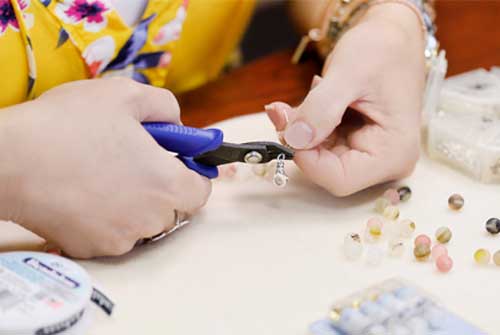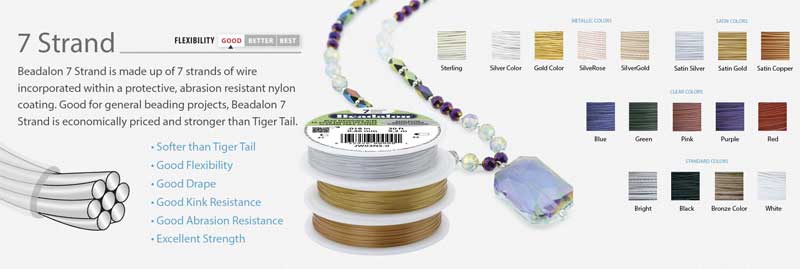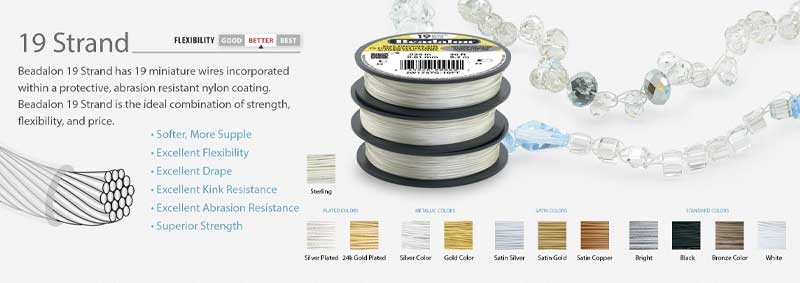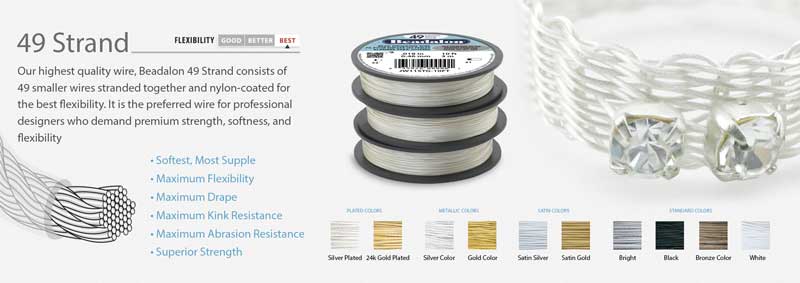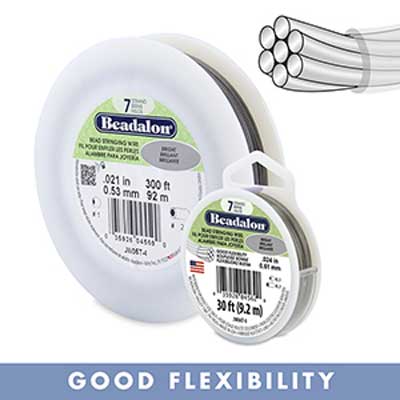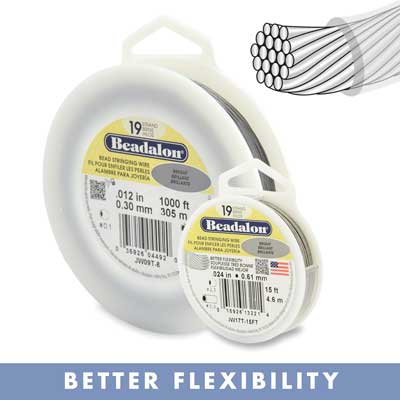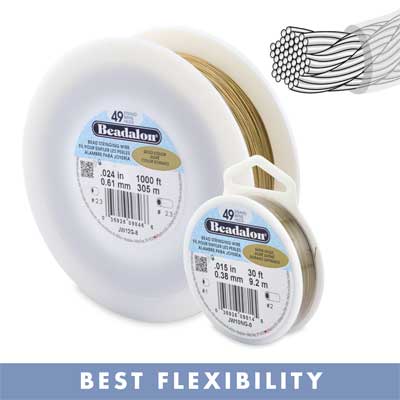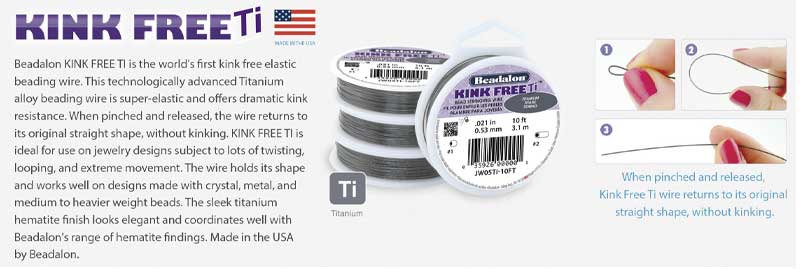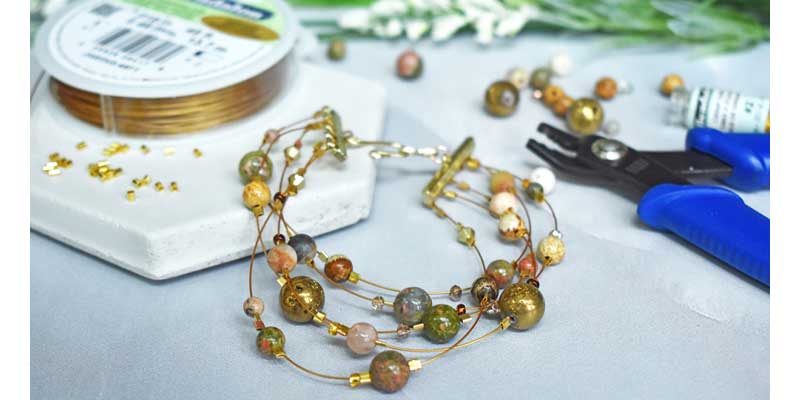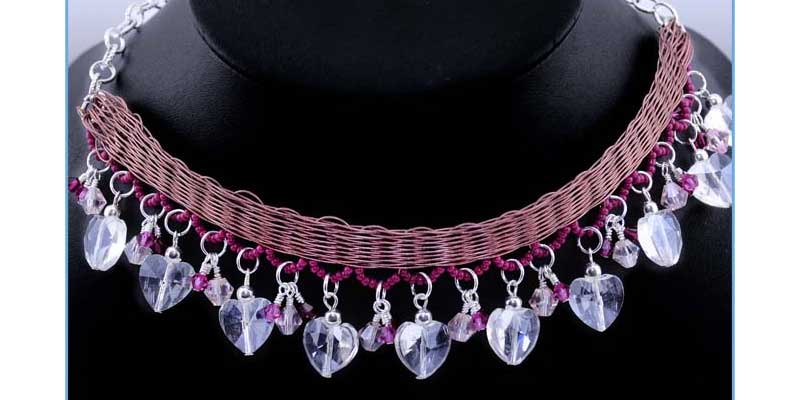| How To Choose The Best Beading Wire For Your Project |
We have been using and selling beading wire for
over 20 years, so we know a thing or two about it. There are many different
types of beading wire thickness to choose from, as well as material and colour.
It can be difficult to decide which beading wire to
use. This blog aims to help you decide which is the best beading wire to
use for your project.
Choosing Which Beading Wire
To Use
When it comes to choosing the correct jewellery beading
wire, we need to move away a little from art and creativity. Instead it is
better to think of wire in engineering terms. The engineering of the wire is
the main reason why there is such a vast and confusing amount of beading wire
to choose from.
Types Of Beading Wire
Beading wire combines multiple strands of wire, like a
miniature jewellery cable. The more strands you have
the more flexible the wire is, the better it drapes, the stronger it becomes
and the more it resists kinking. Due to the improved quality of the wire, the
more strands beading wire has, the more expensive it becomes.
At CJ Beaders we supply 7, 19 and 49 strand Beadalon
beading wire.
We would recommend avoiding less than 7 strands (often known
as tigertail) since it is not very strong, it
kinks easily and does not drape well.
There are four factors to think about when choosing your beading
wire:
1. Your budget
2. How strong the wire needs to be
3. How well you wish the finished piece to drape
4. Is the beading wire visible as part of your design
1. Beading Wire Budget
As is usually the case, you get what you pay for, and it's
no different with beading wire so
it’s important to decide how much you want to spend. It’s also good to bear in
mind the quality of the beads and findings you'll be using and how much use
you’ll get out of the wire.
The most common spool of beading wire comes on a 9.2m spool,
enough for around 15 necklaces. If you divide the retail price by 15, the price
per necklace between 7 and 49 strand is sometimes not a huge amount. You can
purchase better quality jewellery beading wire (19 and 49 strand) in smaller
spools such as 3 or 4.5m spools. This is worth looking out for if you wish to
make a one-off special piece of jewellery or want to try it out before
committing to a bigger spend.
As we mentioned before, it’s also good to consider the jewellery
beads you are stringing. Why spend a lot of money on high-quality jewellery beads
such as Miyuki beads, if you are going to string
them on a cheap beading wire? Particularly if you are going to sell the
finished piece, then every part of your hand-made creation should match in
quality.
2. How Strong Does Beading Wire Need To Be?
At this stage, you
need to apply some consideration to the type and quantity of beads you want to
use. For example, Pearls tend to be fairly light-weight and are suitable for
use in abundance on this wire. Heavier semi-precious or glass beads will require
a much thicker beading wire to carry their weight. This is both in both terms
of 'physical' weight and 'design' weight to avoid them taking over and changing
the shape of your design. Use the thickest beading wire that will comfortably
fit through the hole of the beads you are stringing to give the maximum
strength.
The thinnest beading
wire thickness is about 0.25mm in diameter and the thickest is 0.91mm. As well
as improving the overall quality of the beading wire, the number of strands
also makes a difference to the strength. For example, 7 strand beading wire 0.38mm diameter 'Bright' colour has a
breaking strain of 6.8 Kg. 49 strands in the same diameter has a breaking
strain of 9.1 Kg.
Even though 6.8 Kg
is heavy and you may think; "I do not want to have something as heavy as
that around my neck", the breaking strain weight is at-rest. If you think
back to school science lessons, the force applied to a swinging long necklace
is much more. Therefore, the breaking strain is easily exceeded with thinner or
fewer strands of beading wire. Another consideration here is to how long your
design is. Is it easy to catch on something external or even yourself, and
therefore putting excess force on the beading wire? A long hanging, free-moving
necklace can exert more force at the bottom of the strung wire or at the clasp,
so check these weak points regularly.
Something else to
bear in mind is the material of the beading wire. Beadalon makes beading
wire in different varieties. This includes titanium, stainless steel plated stainless
steel, coloured alloys, sterling silver and Spectra® cord
called Hybraid. Stainless
Steel and Plated Stainless Steel are the strongest wires. Sterling
Silver is the weakest
with a breaking strain of just 3kg. (we wouldn't recommend Sterling Silver
Wire for designs that will see day to day use. Instead this is best
reserved for special occasion pieces).
3. Beading Wire Drape
If you wish to have
the best possible thread-like drape, then 49 Strand is the best, particularly
for lighter weight beads such as pearls. However, there are times when you want
your wire to have more shape, for instance when you weave with wire or want to
form a design with multiple strands. This is when a 7 strand beading wire may give a
better effect.
The weight of the
beads you’re using can make a better drape. However, you choose the cheaper
wire if you can afford the better wire instead. 7 strand beading wire and to a
lesser extent 19 strand beading wire will kink, so
the finished item of jewellery will not drape as well. 49 strand beading wire will have an
imperceptible kink (in fact it's the nylon coating that causes the slight
kink here).
Another factor to
take into account is the length of the piece. Drape is not so important on a
short bracelet or earrings, as the chances are the beads will not cause the
piece to become misshapen. However, longer or heavier pieces can affect the
drape overall, as can how you store your finished article. Fold a necklace or
bracelet made with a lower number of strands into a box or bag and it will
never be the same again. The exception to the rule is Titanium Wire (as shown above) – it is completely
kink-free, but only comes in three sizes and one colour - grey.
4. Beading Wire Colours
When you're
designing your piece, have you thought about how the beading wire will feature
in your design? This will impace the colour of jewellery wire you want to use.
Will it be completely covered by beads charms and findings? Are the beads
you're using opaque or block colours, or are they lined or transparent? Do you
want to incorporate the wire as part of the jewellery, such as in illusion
style projects?
Beadalon beading
wire is available in a range of colours - and all of them have a clear nylon
coating. If your design just uses opaque beads and a hidden wire, then go
for the 'standard' colours of Bright (raw stainless steel), black or bronze. The
latter adds a nice shine to designs. If you are using translucent glass
beads or crystals, then metallic plated wire will reflect through the Beads and
make the colours of the beads brighter. Incorporate the wide range of colours available
into your designs to good effect with the wire forming part of your design.
You can plate Stainless
Steel Wire with other metals, typically Silver, Gold and Copper. This means the
plating retains the strength of the Stainless Steel core. However, alloy wire reduce
costd, but also reduce the strength of the wire. If strength is really
important and you want a metallic colour, then choose plated jewellery wires.
Discover Quality Beading And Jewellery Wire Online
At CJ Beaders
We hope this
article has been useful. As experts in beading art and jewellery beading wire,
we’re here to answer any questions you might have. Get in contact with us and we can help you
choose the right beading wire for your project. To speak to a member of our
team give us a call on 01202
798151. We offer free delivery on all orders over £25.

